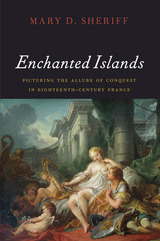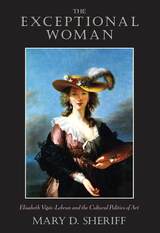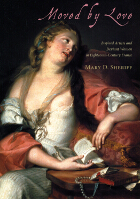5 books about Sheriff, Mary D.

Enchanted Islands
Picturing the Allure of Conquest in Eighteenth-Century France
Mary D. Sheriff
University of Chicago Press, 2018
In Enchanted Islands, renowned art historian Mary D. Sheriff explores the legendary, fictional, and real islands that filled the French imagination during the ancien regime as they appeared in royal ballets and festivals, epic literature, paintings, engravings, book illustrations, and other objects. Some of the islands were mythical and found in the most popular literary texts of the day—islands featured prominently, for instance, in Ariosto’s Orlando furioso,Tasso’s Gerusalemme liberata, and Fénelon’s, Telemachus. Other islands—real ones, such as Tahiti and St. Domingue—the French learned about from the writings of travelers and colonists. All of them were imagined to be the home of enchantresses who used magic to conquer heroes by promising sensual and sexual pleasure. As Sheriff shows, the theme of the enchanted island was put to many uses. Kings deployed enchanted-island mythology to strengthen monarchical authority, as Louis XIV did in his famous Versailles festival Les Plaisirs de l’île enchantée. Writers such as Fénelon used it to tell morality tales that taught virtue, duty, and the need for male strength to triumph over female weakness and seduction. Yet at the same time, artists like Boucher painted enchanted islands to portray art’s purpose as the giving of pleasure. In all these ways and more, Sheriff demonstrates for the first time the centrality of enchanted islands to ancient regime culture in a book that will enchant all readers interested in the art, literature, and history of the time.
[more]

The Exceptional Woman
Elisabeth Vigee-Lebrun and the Cultural Politics of Art
Mary D. Sheriff
University of Chicago Press, 1996
Elisabeth Vigée-Lebrun (1755-1842) was an enormously successful painter, a favorite portraitist of Marie-Antoinette, and one of the few women accepted into the Royal Academy of Painting and Sculpture. In accounts of her role as an artist, she was simultaneously flattered as a charming woman and vilified as monstrously unfeminine.
In The Exceptional Woman, Mary D. Sheriff uses Vigée-Lebrun's career to explore the contradictory position of "woman-artist" in the moral, philosophical, professional, and medical debates about women in eighteenth-century France. Paying particular attention to painted and textual self-portraits, Sheriff shows how Vigée-Lebrun's images and memoirs undermined the assumptions about "woman" and the strictures imposed on women.
Engaging ancien-régime philosophy, as well as modern feminism, psychoanalysis, literary theory, and art criticism, Sheriff's interpretations of Vigée-Lebrun's paintings challenge us to rethink the work and the world of this controversial woman artist.
In The Exceptional Woman, Mary D. Sheriff uses Vigée-Lebrun's career to explore the contradictory position of "woman-artist" in the moral, philosophical, professional, and medical debates about women in eighteenth-century France. Paying particular attention to painted and textual self-portraits, Sheriff shows how Vigée-Lebrun's images and memoirs undermined the assumptions about "woman" and the strictures imposed on women.
Engaging ancien-régime philosophy, as well as modern feminism, psychoanalysis, literary theory, and art criticism, Sheriff's interpretations of Vigée-Lebrun's paintings challenge us to rethink the work and the world of this controversial woman artist.
[more]

Fragonard
Art and Eroticism
Mary D. Sheriff
University of Chicago Press, 1990
In the aftermath of the French Revolution, Jean Honoré Fragonard, perhaps the most significant French painter of the eighteenth century, was condemned first as a purveyor of luxury items and later as an artist who abandoned noble subjects for the erotic genre. In this revisionist, art-historical study, Mary D. Sheriff challenges such pejorative views of Fragonard by arguing that he is better understood as an artist whose unsurpassed technical skill and witty manipulation of academic standards established a dynamic relation with the audience his art both courted and created.
Sheriff begins her inquiry with an appraisal of Fragonard criticism, followed by an extensive and thoroughly original reading of selected works by Fragonard and of the eroticism encoded in them. Art and eroticism converge in a discussion of execution, in which Sheriff explores the changing conception of execution and elucidates its complex rhetorical and cultural underpinnings. Drawing on analytic methods from contemporary critical theory and an understanding of each work's cultural milieu, Sheriff pays particular attention throughout to the relation between beholder and work of art, which she views as manifest in the artist's preoccupation with the play between the real and the fictive. Scholars and students of art history, eighteenth-century culture and history, critical theory, literary criticism, and all those drawn to the work of this great French painter will find this work essential reading.
Sheriff begins her inquiry with an appraisal of Fragonard criticism, followed by an extensive and thoroughly original reading of selected works by Fragonard and of the eroticism encoded in them. Art and eroticism converge in a discussion of execution, in which Sheriff explores the changing conception of execution and elucidates its complex rhetorical and cultural underpinnings. Drawing on analytic methods from contemporary critical theory and an understanding of each work's cultural milieu, Sheriff pays particular attention throughout to the relation between beholder and work of art, which she views as manifest in the artist's preoccupation with the play between the real and the fictive. Scholars and students of art history, eighteenth-century culture and history, critical theory, literary criticism, and all those drawn to the work of this great French painter will find this work essential reading.
[more]

French History in the Visual Sphere, Volume 26
Daniel Sherman and Mary D. Sheriff
Duke University Press

Moved by Love
Inspired Artists and Deviant Women in Eighteenth-Century France
Mary D. Sheriff
University of Chicago Press, 2004
In eighteenth-century France, the ability to lose oneself in a character or scene marked both great artists and ideal spectators. Yet it was thought this same passionate enthusiasm, if taken to unreasonable extremes, could also lead to sexual deviance, mental illness—even death. Women and artists were seen as especially susceptible to these negative consequences of creative enthusiasm, and women artists, doubly so.
Mary D. Sheriff uses these very different visions of enthusiasm to explore the complex interrelationships among creativity, sexuality, the body and the mind in eighteenth-century France. Drawing on evidence from the visual arts, literature, philosophy, and medicine, she portrays the deviance ascribed to both inspired men and women. But while various mythologies worked to normalize deviance in male artists, women had no justification for their deviance. For instance, the mythical sculptor Pygmalion was cured of an abnormal love for his statue through the making of art. He became a model for creative artists, living happily with his statue come to life. No happy endings, though, were imagined for such inspired women writers as Sappho and Heloise, who burned with erotomania their art could not quench. Even so, Sheriff demonstrates, the perceived connections among sexuality, creativity, and disease also opened artistic opportunities for creative women took full advantage of them.
Brilliantly reassessing the links between sexuality and creativity, artistic genius and madness, passion and reason, Moved by Love will profoundly reshape our view of eighteenth- century French culture.
Mary D. Sheriff uses these very different visions of enthusiasm to explore the complex interrelationships among creativity, sexuality, the body and the mind in eighteenth-century France. Drawing on evidence from the visual arts, literature, philosophy, and medicine, she portrays the deviance ascribed to both inspired men and women. But while various mythologies worked to normalize deviance in male artists, women had no justification for their deviance. For instance, the mythical sculptor Pygmalion was cured of an abnormal love for his statue through the making of art. He became a model for creative artists, living happily with his statue come to life. No happy endings, though, were imagined for such inspired women writers as Sappho and Heloise, who burned with erotomania their art could not quench. Even so, Sheriff demonstrates, the perceived connections among sexuality, creativity, and disease also opened artistic opportunities for creative women took full advantage of them.
Brilliantly reassessing the links between sexuality and creativity, artistic genius and madness, passion and reason, Moved by Love will profoundly reshape our view of eighteenth- century French culture.
[more]
READERS
Browse our collection.
PUBLISHERS
See BiblioVault's publisher services.
STUDENT SERVICES
Files for college accessibility offices.
UChicago Accessibility Resources
home | accessibility | search | about | contact us
BiblioVault ® 2001 - 2024
The University of Chicago Press









